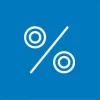With the phasing out of negative key interest rates, Swiss fixed-deposit accounts and medium-term notes experienced a bona fide renaissance. Both of these instruments yield interest at a fixed rate over a predetermined period of time (commonly between one and 10 years).
The interest rates have sunk again in the meantime, but they remain higher, on average, than those of savings accounts. Demand for medium-term notes and fixed deposits remains, in spite of the lower interest rates. They are generally used by people who do not want to invest in riskier asset classes, but expect to earn higher returns than they could with savings accounts.
Average interest rates compared
Currently, the average unweighted annual interest rates for fixed deposit accounts and medium- term notes is 0.73 percent for a one-year term, 0.65 percent for a two-year term, 0.72 percent for a five-year term, and 0.84 percent for a 10-year term. By comparison, the average annual interest rate across Swiss savings accounts for adults is 0.59 percent.
Right now, the average interest rates of medium-term notes and fixed-deposit accounts are somewhat higher than those of savings accounts, observes moneyland.ch’s managing director Benjamin Manz. “The differences in interest rates between fixed deposit terms are not major. Even one-year fixed deposits have interest rates similar to those of 10-year fixed deposits. That makes fixed deposits with short terms of one to two years an alternative to savings accounts.”
Like savings accounts, fixed deposit accounts and medium-term notes are protected against bank insolvencies up to a limit of 100,000 francs per customer and bank. But in contrast to savings accounts, the interest rate of a fixed deposit account or medium-term note remains the same for the full term. Depending on how money markets develop, that can be either an advantage or a disadvantage. If you expect interest rates to go down in the coming years, then using fixed deposits is an advantage because you are guaranteed a certain amount of interest. The disadvantage is that your money is blocked for the full deposit term. Savings accounts have fewer limitations on withdrawals.
Substantial differences between interest rates
Differences between the interest rates offered by different banks are large. According to the moneyland.ch medium-term note and fixed deposit comparison, the individual annual interest rates offered by different banks range from 0.25 to 0.9 percent for a one-year term, from 0.15 to 1.2 percent for a two-year term, from 0.2 to 1.5 percent for a five-year term, and between 0.25 and 1.75 percent for a 10-year term. By comparison, the interest rates of Swiss savings accounts range between 0 and 1.75 percent per annum.
Some banks charge ongoing account fees or custody fees for medium-term notes or fixed deposit accounts which detract from your interest earnings. The moneyland.ch comparison accounts for these costs. When choosing a fixed deposit or medium-term note offer, you need to account for possible costs in addition to interest earnings.
Table 1: Highest-yield medium-term notes and fixed deposit accounts with a one-year term
| Bank |
Annual interest rate |
| Bank BSU |
0.8%-0.9%* |
| Glarner Regionalbank |
0.85% |
| Bank WIR |
0.8% |
| Crédit Agricole next bank |
0.74% |
| Sparhafen Bank |
0.7% |
*BSU: Zinssatz steigt mit Anlagebetrag an, 0.9% ab CHF 1 Mio.
Table 2: Highest-yield medium-term notes and fixed deposit accounts with a two-year term
| Bank |
Annual interest rate |
| Bank EKI |
1.2% |
| Hypo Vorarlberg |
1.15% |
| Cembra Money Bank |
1.1% |
| Spar- und Leihkasse Frutigen |
1.05% |
| Bank CIC |
1% |
| Banca Popolare di Sondrio |
1% |
Highest-yield medium-term notes and fixed deposit accounts with a five-year term
| Bank |
Annual interest rate |
| Hypo Vorarlberg |
1.5% |
| Caisse d'Epargne d'Aubonne |
1.3% |
| Bank EKI |
1.2% |
| Cembra Money Bank |
1.2% |
| BBO Bank Brienz Oberhasli |
1.15% |
| Spar- und Leihkasse Frutigen |
1.15% |
| Bank CIC |
1.05% |
The medium-term note and fixed deposit comparison on moneyland.ch shows the interest rates of fixed deposits from more than 50 different banks. The tables above show the franc-denominated offers with the highest interest rates, without accounting for costs. Date: October 16, 2024. Offers for new applicants can change at any time.
More on this topic:
Compare Swiss fixed deposit accounts and medium-term notes now


 Deal of the Day
Deal of the Day 





